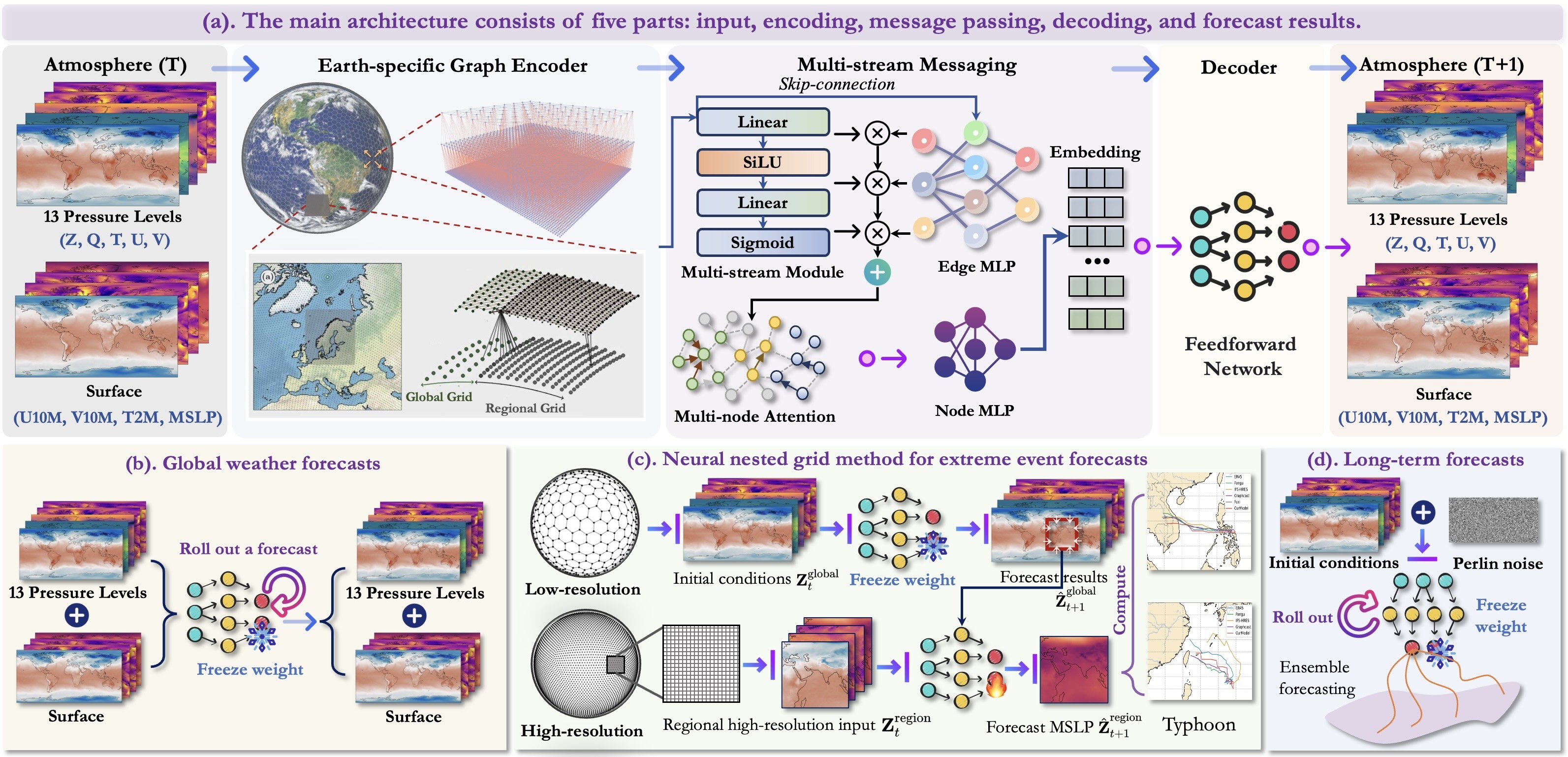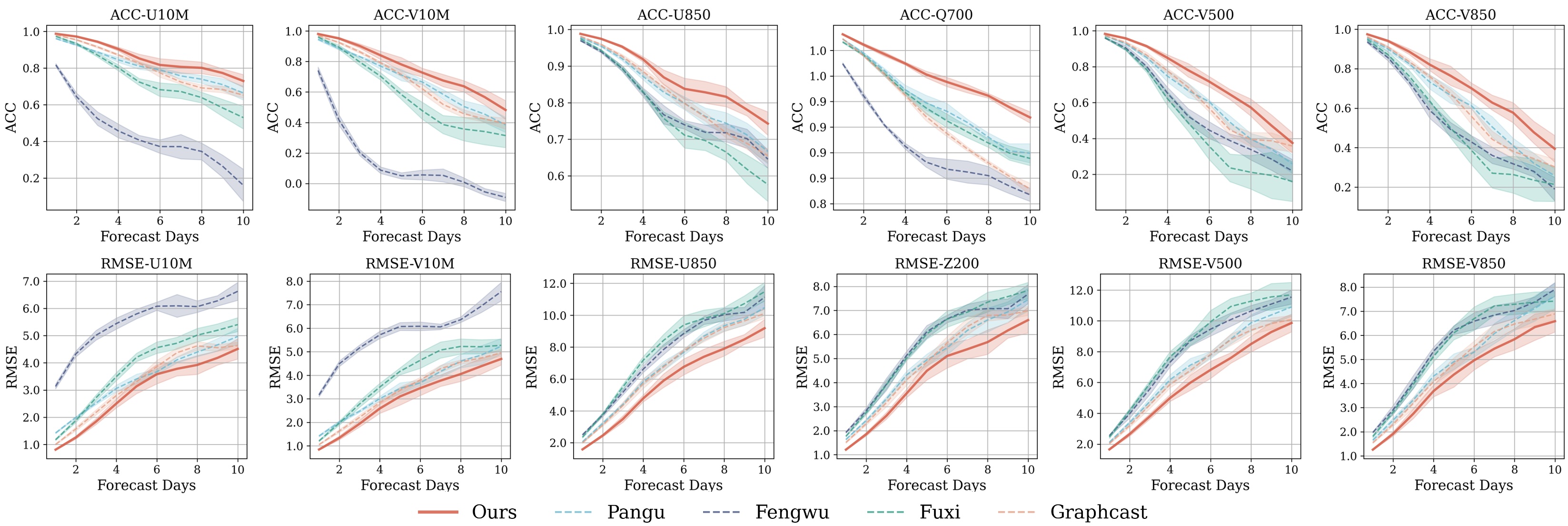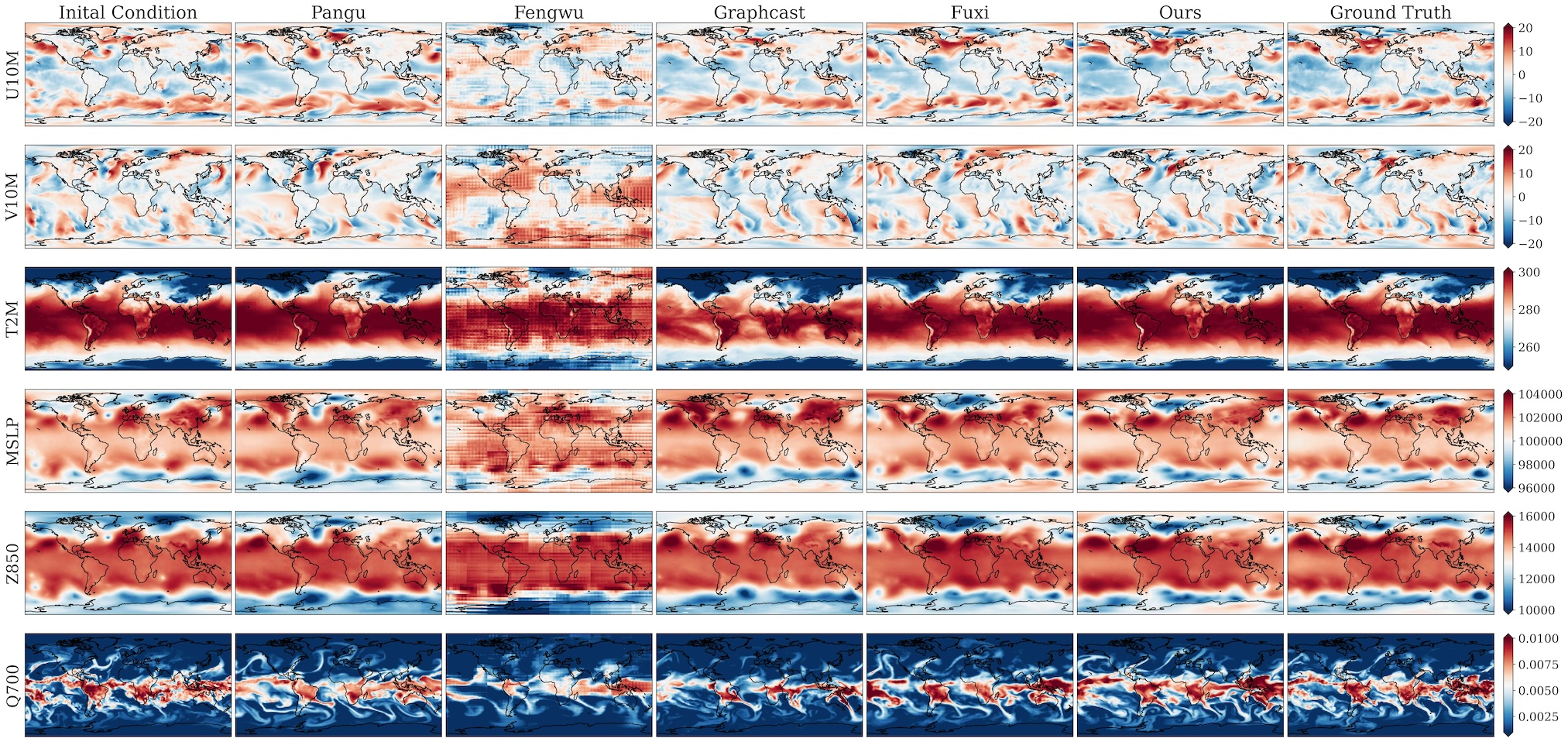Accurate weather forecasts are important for disaster prevention, agricultural planning, and water resource management. Traditional numerical weather prediction (NWP) methods offer physically interpretable high-accuracy predictions but are computationally expensive and fail to fully leverage rapidly growing historical data. In recent years, deep learning methods have made significant progress in weather forecasting, but challenges remain, such as balancing global and regional high-resolution forecasts, excessive smoothing in extreme event predictions, and in sufficient dynamic system modeling. To address these issues, Professor Huang Xiaomeng’s Research Team of the Department of Earth System Science (DESS), Tsinghua University, in collaboration with several institutions, has developed OneForecast, a global-regional nested weather forecasting framework based on graph neural networks (GNNs). The related paper has been published online in preprint form (https://arxiv.org/abs/2502.00338). Meanwhile, related codes are available at https://github.com/YuanGao-YG/OneForecast.

Figure 1 Main Architecture of OneForecast
By combining a dynamic system perspective with multi-grid theory, we construct a multi-scale graph structure and densify the target region to capture local high-frequency features. We introduce an adaptive information propagation mechanism, using dynamic gating units to deeply integrate node and edge features for more accurate extreme event forecasting. For high-resolution regional forecasts, we propose a neural nested grid method to mitigate boundary information loss. Experimental results show that the proposed method performs excellently across global to regional scales and short-term to long-term forecasts, especially in extreme event predictions (e.g., typhoons), significantly improving forecast accuracy.
OneForecast mainly consists of a region-refined multi-scale graph structure, an adaptive information propagation mechanism, and a dynamic neural nested gridding method. Inspired by the ideas of multi-scale graphs and multigrid methods, OneForecast introduces an Earth-specific multi-level Graph Neural Network architecture that includes grids of multiple granularities to improve the interaction of node features in complex dynamical systems. This design not only enables the modeling of atmospheric motions across various scales but also enhances the forecasting accuracy for specific regions as needed.
To address the issue of information transmission between nodes in complex dynamic systems, we propose a module called Multi-stream Messaging (MSM). This module consists of an adaptive messaging mechanism, including a dynamic multi-head gated edge update module and a multi-head node attention mechanism. Compared to traditional message passing mechanisms, multi-head attention mechanisms can more precisely capture complex dependencies between nodes and dynamically adjust the way information is aggregated through attention weights. For each edge, we concatenate its own features with those of the source node and the target node. Subsequently, we use Edge Sum MLP (ESMLP) to perform linear transformation and nonlinear activation on the edge features to generate the updated edge features. Finally, we concatenate the aggregated edge features with the original node features and, through an MLP, perform a nonlinear transformation to generate the updated node features. Compared to traditional node update mechanisms, multi-head attention mechanisms can more precisely capture complex dependencies between nodes and dynamically adjust the way information is aggregated through attention weights.
Although the training cost of low-resolution forecast models is relatively low, their prediction results lack sufficient details. However, directly training on high-resolution regional data often results in poor regional forecasts performance due to issues such as missing boundary conditions and limited data samples. To enhance the accuracy of high-resolution forecasts in specific regions, OneForecast proposes a neural nested grid (NNG) method. This method combines global low-resolution future forecasts with regional high-resolution data to enhance the accuracy of local high-resolution forecasts. NNG makes full use of global model information and provides the necessary boundary conditions for the regional forecasts.
For the global weather forecasts, OneForecast chooses the 1.5° version of WeatherBench2 as its dataset, a subset of the fifth generation of ECMWF Reanalysis Data (ERA5) , of which 1959-2017 is for training, 2018-2019 for validating, and 2020 for testing. We use 5 pressure level variables (each with 13 pressure levels), geopotential (Z), specific humidity (Q), temperature (T), U and V components of wind speed (U and V), and 4 surface level variables 10-meter U and V components of wind (U10M and V10M), 2-meter temperature (T2M), and Mean sea-level pressure (MSLP). For regional weather forecasts, we use the original 0.25°ERA5 data. OneForecast demonstratively selects U10M and T2M for regional high-resolution forecasting.
OneForecast evaluates the results of global weather forecast, local high-resolution forecast, extreme event forecast, long-term forecast and ensemble forecast. For 1.5° global weather forecast, the forecast results of OneForecast for 6h, 1d, 4d, 7d and 10d are competitive with the existing methods (one initial condition every 6h, the average of 1300 initial conditions). Specifically, compared with Pangu, Fengwu, Graphcast and Fuxi, OneForecast has achieved better results in both RMSE (Root Mean Square Error) and ACC (Anomalous Correlation Coefficient). Besides, the forecast results of OneForecast is visually more physically consistent.

Fig. 2 Quantitative assessment of global weather forecasts
 Fig. 3 Quantitative assessment of global forecasts
Fig. 3 Quantitative assessment of global forecasts

Fig. 4 10-day forecast results
For regional high-resolution forecasts, although the regional forecasts method proposed by Graph-EFM improves prediction accuracy, it remains constrained by the absence of global information in high-resolution regional models. In contrast, the Neural Nesting Grid (NNG) method proposed by OneForecast incorporates boundary conditions and global future information, enabling more accurate high-resolution regional predictions. Furthermore, NNG makes full use of the forecast results of global models, which achieves high-resolution regional forecasts at an exceptionally low training cost. Therefore, OneForecast only demonstratively conducts high-resolution predictions for two regional variables without requiring training on all variables (e.g., the 69 variables used for training global models). It can be seen that the poor long-term inference results are poor when only using regional data for training. Graph-EFM takes into account boundary conditions and the effect is improved. And our proposed NNG not only takes into account regional boundary conditions, but also makes full use of the future forecast information of the global model, which achieves stable long-term forecast performance.

Fig. 5 Regional high-resolution forecast results
In addition, in the forecasts of typhoon Yagi in 2018 and typhoon Molave in 2020, OneForecast could accurately predict the typhoon path. Although OneForecast uses lower resolution (1.5°) data, its ability in typhoon track prediction is equivalent to that of the baseline model using higher resolution (0.25°) data. The Multi-stream Messaging (MSM) proposed by OneForecast can better capture high-frequency information, thus achieving satisfactory results in long-term forecasting and extreme event forecasting.

Fig. 6 Extreme event (typhoon) forecast evaluation (left); Normalized Spectral Error (right) of the proposed MSM and the traditional MLP-based massaging (right)
Finally, this study evaluates the results of long-term forecasting and ensemble forecasting. AI-based weather forecasting models normally cannot achieve long-term stable reasoning, this study analyzes the effect of longer reasoning of the two baseline models with the best performance. For example, Pangu exhibits patch artifacts in 100-day forecasts, while GraphCast experiences error accumulation that degrades the forecasted physical fields, rendering them physically implausible over time. In contrast, OneForecast achieves stable long-term forecast performance, effectively capturing large-scale atmospheric states without the aforementioned issues. Besides, the initial condition of the atmospheric state is uncertain, so reasonable quantification of this uncertainty is conducive to improving forecast performance. OneForecast adds Perlin noise to achieve ensemble forecasting. The 4-day and 10-day forecast results of 10 initial conditions (each with 50 members) show that OneForecast is superior to other models. In addition, because OneForecast can accurately model the atmospheric state, in short-term forecast such as 4-day forecast, the result of deterministic forecast is better, while other models still need to use ensemble forecast method to improve their performance due to factors such as large errors.

Fig. 7 100-day long-term reasoning evaluation (left); ensemble forecast quantitative evaluation (right)
To conclude, OneForecast is a global-regional nested weather forecasting framework leveraging multi-scale graph neural networks. By integrating dynamical systems principles with multi-grid structures, our approach refines target regions to model atmospheric dynamics at various scales and improve forecast accuracy of target regions. The adaptive information propagation mechanism, featuring dynamic gating units, mitigates over-smoothing and enhances node-edge feature representation and achieves improved capture of high-frequency features and forecast of extreme events. Additionally, the proposed neural nested grid (NNG) method preserves global information for regional forecasts, effectively relieves the loss of boundary information, which improves the regional forecast performance. Empirical results show that the proposed OneForecast achieves higher prediction accuracy at global and regional scales, especially for long-term and extreme event predictions, marking excellent potentiality of AI-based weather forecasting for weather forecasting, which will gradually become a powerful supplement to traditional numerical approaches.
High-resolution data can often be used to analyze more complex dynamic systems. In the future, OneForecast will balance resolution and calculation cost to achieve more accurate and efficient weather forecast. In addition, the Earth system is a unified whole composed of multiple layers, and the interaction between multiple layers needs to be considered in higher precision prediction. The team will soon release an atmosphere-ocean coupling forecast model based on graph neural network to improve forecasting accuracy, especially the ability to predict extreme events.
Professor Huang Xiaomeng of the Department of Earth System Science (DESS), Tsinghua University is the corresponding author of the paper, and Gao Yuan, a doctoral student, Wu Hao, a master student (jointly trained by the Department of Information Science and Technology of the Chinese University of Science and Technology-Tencent Machine Learning Platform Department) and Shu Ruiqi, a doctoral student, are the co-first authors of the paper. Collaborators include Dong Huanshuo and Xu Fan, master students of Information and Intelligence Faculty of the University of Science and Technology of China, Chen Rui, an undergraduate student of Yao Class of Institute for Interdisciplinary Information Sciences (IIIS), Tsinghua University, Yan Yibo, a doctoral student of the Department of Computer Science and Engineering of the Hong Kong University of Science and Technology, Wen Qingsong, head and chief scientist of Squirrel AI Learning Artificial Intelligence, Assistant Professor Hu Xuming, of the Department of Computer Science and Engineering of the Hong Kong University of Science and Technology, Wang Kun, a postdoctoral fellow of the Department of Computer Science and Engineering of Nanyang Technological University, Wu Jiahao, a doctoral student of the Department of Computing of Hong Kong Polytechnic University, Professor Li Qing of the Department of Computer Science and Engineering of Hong Kong University of Science and Technology, The research is supported by the National Key Research and Development Program and the National Natural Science Foundation of China.
Written by Huang Xiaomeng Research Team
Edited by Wang Jiayin
Reviewed by Zhang Qiang